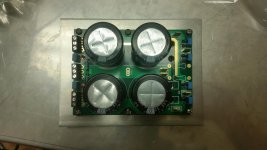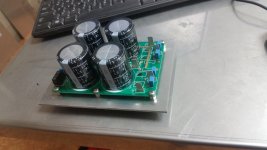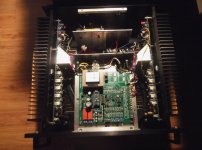I just finished etching the boards so I will have to use your fix as well. Can you post fhe fix in that thread so we don't clutter this one? Besides others will need to know the fix as well.
Thanks, Terry
Thanks, Terry
I just finished etching the boards so I will have to use your fix as well. Can you post fhe fix in that thread so we don't clutter this one? Besides others will need to know the fix as well.
Thanks, Terry
Terry, could you point out what boards you've etched, I have more PCB suggestion over there?
BR Damir
Terry, could you point out what boards you've etched, I have more PCB suggestion over there?
BR Damir
I got the file here
I got the file here
Hi Terry, I edited the layout and the last correct schematic and it's last post in my TT thread.
I think you can see from the layout what to correct, the trimmer P1 and resistor R35(before R44) interchanged the positions and changed the values.
BR Damir
Like everybody else, before and after me, i tried hard to get rid of the crossover distortion while keeping a reasonable quiescent current.Kean, as basic principle to have error correction and min output bias this sch is worth to explore more. With a little help of current mirrors to simplify bias conditions and anti-latching circuitry in a form of diodes there could be a way to practical working circuit. Still some simm work ahead for all interested.
By all the ways i could imagine.
No real success, so far.
Giving-it up, i thing the simple way is to allow enough quiescent for Class A operation at normal levels, and accept very short incursions in class B during high levels transients. Too short for the ears can notice the high order harmonics, (and, may-be, it can bring some feeling of added dynamic ?).
That we achieve without any effort with laterals at their best point, specially when paralleling them ;-).
As you did with your FO ?
Notice that this is an argument to use high efficiency speakers as well.
High efficiency speakers bring on a new batch of issues. I find most amps don't perform well at very low power levels that would never be played on normal speakers. I haven't had a chance to try out any of my Slewmaster series on my good speakers yet but I've noticed quite a difference in other amplifiers that others have really liked. I'm thinking it may be speed related in the amplifier. In older designs higher power supplies have almost always sounded better. I'm playing a new fast design on 40 volt rails now and it's the best I've heard yet.Like everybody else, before and after me, i tried hard to get rid of the crossover distortion while keeping a reasonable quiescent current.
By all the ways i could imagine.
No real success, so far.
Giving-it up, i thing the simple way is to allow enough quiescent for Class A operation at normal levels, and accept very short incursions in class B during high levels transients. Too short for the ears can notice the high order harmonics, (and, may-be, it can bring some feeling of added dynamic ?).
That we achieve without any effort with laterals at their best point, specially when paralleling them ;-).
As you did with your FO ?
Notice that this is an argument to use high efficiency speakers as well.
Oh ? Too noisy ? Or bad speakers that need high acoustic levels to hide their lacks?I find most amps don't perform well at very low power levels that would never be played on normal speakers.
My amp is ~200W (+-70V rails) and my speakers 98dB/W. And sound nice at lowest levels, not loosing basses.
A CFA, by the way ;-)
Last edited:
Mine are 105 dB/W excellent speakers (Klipsch Chorus). I've noticed the same on Klipsch Belles. The amp I liked the best so far is Valery's CFA-CFP. I've never tried it at the proper rail voltage yet. Second best was a Parasound 200 watt amp(I don't remember the model). I've tried many amps on them. Old wooden 100 lb Sansuis and Pioneers sounded good too. Bryston 3B wasn't really great.
tss tss: 101dB/W ;-)Mine are 105 dB/W excellent speakers (Klipsch Chorus).
When designing speaker drivers you trade one set of benefits over another, higher efficiency drivers are noisy, simply because of turbulence noise in a narrow magnet gap, but then they are efficient, with larger magnet gaps the airflow is laminar and quiet, but at a lower efficiency. PICK your poison.
When designing speaker drivers you trade one set of benefits over another, higher efficiency drivers are noisy, simply because of turbulence noise in a narrow magnet gap, but then they are efficient, with larger magnet gaps the airflow is laminar and quiet, but at a lower efficiency. PICK your poison.
My issue has never been with the driver. It's always been with higher frequencies just going flat at low volume. Tube amps like Anthems sound great on them. I see no reason why a solid state amp can't do the same. That's what I'm shooting for. As I said so far Valery's CFA-CFP has done it. I'm thinking the Slewmasters will as well. I just need some time to try them out.
Do any of you guys have more slewmasters 2 OPS left?
More builders that testet kypton c boards until now?
I have seen several times measurements amplifier 2W @ 8ohm is this regarding
Cross over distortion since it's relevant?
More builders that testet kypton c boards until now?
I have seen several times measurements amplifier 2W @ 8ohm is this regarding
Cross over distortion since it's relevant?
200W class A.
Yes , Ive heard the same speakers (tweeters) I have now on a "true A".
RS28 dayton's ( 5 years) sound pretty close on these "slews" , low volume to
medium volume.
The 35W pioneer is acceptable , but noticeably "challenged". The 90W H/K
is still the winner with two output pairs .
BUT , I have just one pair outputs on the spooky and it matches the HK to
half volume. The highs are actually clearer.
So , if I'm matching a "rave review amp" (HK680) with a half built DIY -
what "holy grail" should I seek next ? 😕 (hyperbolic conversion amp ??)
I know with 5 pair , I'll have 5X the class A region and will be able to
"crank" my big dayton 8" system (they have the RS28 tweeter , too).
OS
Yes , Ive heard the same speakers (tweeters) I have now on a "true A".
RS28 dayton's ( 5 years) sound pretty close on these "slews" , low volume to
medium volume.
The 35W pioneer is acceptable , but noticeably "challenged". The 90W H/K
is still the winner with two output pairs .
BUT , I have just one pair outputs on the spooky and it matches the HK to
half volume. The highs are actually clearer.
So , if I'm matching a "rave review amp" (HK680) with a half built DIY -
what "holy grail" should I seek next ? 😕 (hyperbolic conversion amp ??)
I know with 5 pair , I'll have 5X the class A region and will be able to
"crank" my big dayton 8" system (they have the RS28 tweeter , too).
OS
My vfa cfa toys, still under "development"
VFA frontend
https://plus.google.com/photos/106882583920049206569/albums/6097854316441595153
CFA frontend
https://plus.google.com/photos/106882583920049206569/albums/6097898270142378721
HEC buffer
https://plus.google.com/photos/106882583920049206569/albums/6048122693335650689
VFA frontend
https://plus.google.com/photos/106882583920049206569/albums/6097854316441595153
CFA frontend
https://plus.google.com/photos/106882583920049206569/albums/6097898270142378721
HEC buffer
https://plus.google.com/photos/106882583920049206569/albums/6048122693335650689
I know with 5 pair , I'll have 5X the class A region
Why, do you have issue with class-B in such a high voltage and complex CFA?? I have been working with simpler CFA and with much lower voltage and I have come to a conclusion that the performance in class-B is not "acceptable" (to my standard) at all so the solution is of course a class-A. I was shooting for 1A but temporarily settled with 1.1A.
I don't know whether I will go into a higher power territory because I believe that such big power is only needed for passive woofer in a 3-way. Currently I'm running passive for the 2-way and planning for active for the big woofer.
The LPF for the big woofer will use ordinary opamps but to equalize the passive 2-way (HPF) I use a combination of 1x JFET buffer, 2x discrete opamps and top of the line AD opamps.
I received my modular supply boards today with some cosmetic malfunctions from the board house.
Was the board house in Lufeng, Guangdong (china meth city) ? 😀😀
What's that orphan trace on the V+ side ?
As long as it goes nowhere - they still look good. (big discount for screwup ?)
PS - Been playing the jury- rigged slewmaster (below). Dead silent - even with jury
rigged grounds.
OS
Attachments
That's a good looking build OS!
Thanks , that's the "raw" (jury- rigged) version ... but it works perfectly.
I'm listening to home theater on it now.
Wife told me it could not be like a project - had to be OEM 😀 (safe and
with a factory look).
Only running both channels (1 pair njw0281/0302) with 2 X 8200u.
When done - I'll take some perfect pictures.
OS
Was the board house in Lufeng, Guangdong (china meth city) ? 😀😀
What's that orphan trace on the V+ side ?
As long as it goes nowhere - they still look good. (big discount for screwup ?)
PS - Been playing the jury- rigged slewmaster (below). Dead silent - even with jury
rigged grounds.
OS
That trace is just missing solder mask. It's the same on the underside. I need to check the Gerber files and see if something happened there. These boards are so cheap to get made it's not worth the time to haggle over a cosmetically screwed up one though.
Your amp's looking good. It's getting really full inside there.
- Home
- Amplifiers
- Solid State
- Slewmaster - CFA vs. VFA "Rumble"


